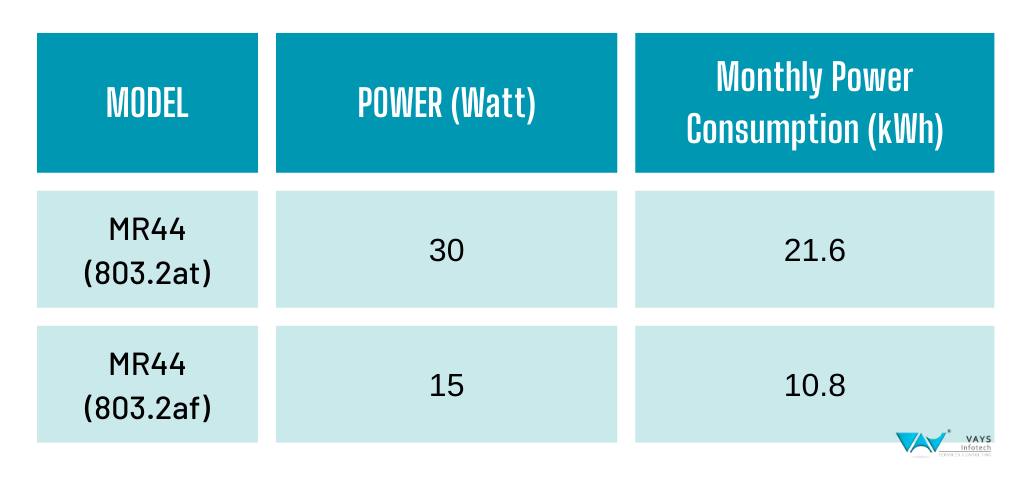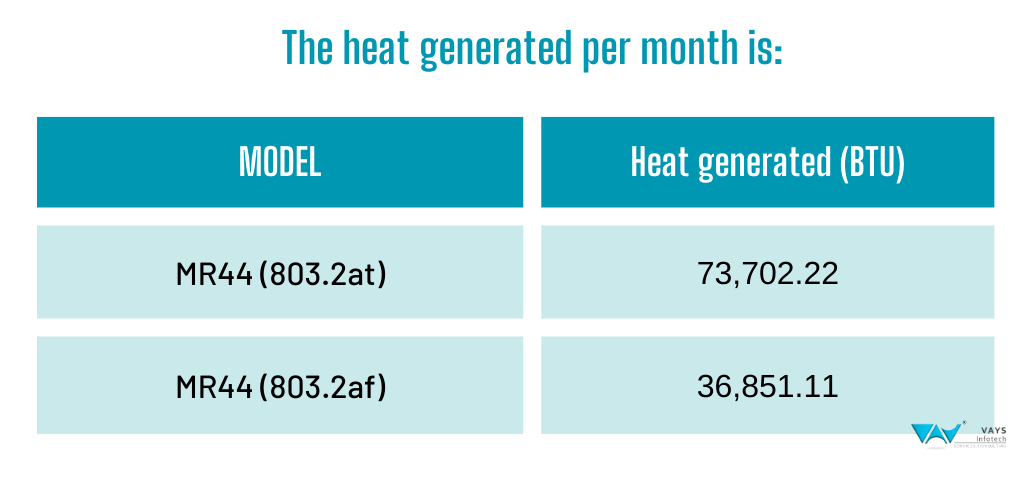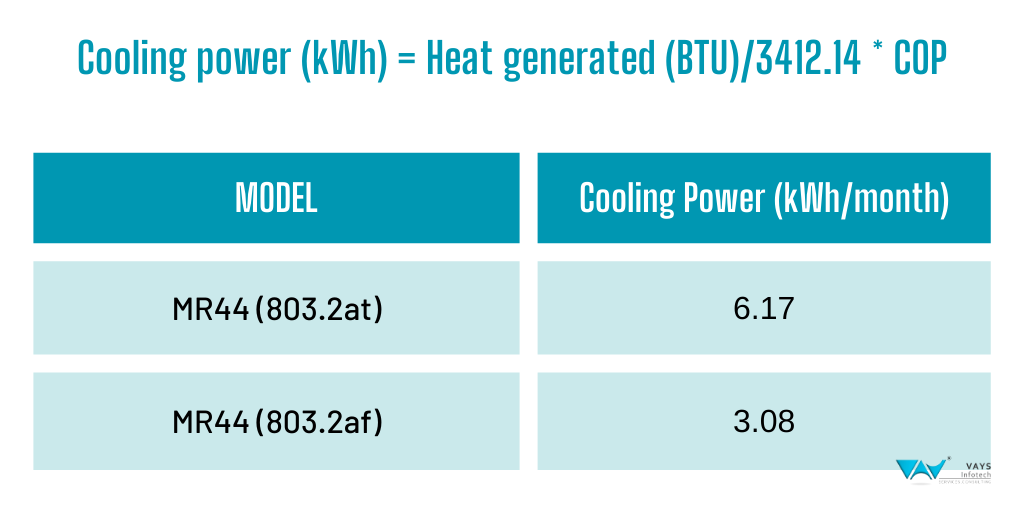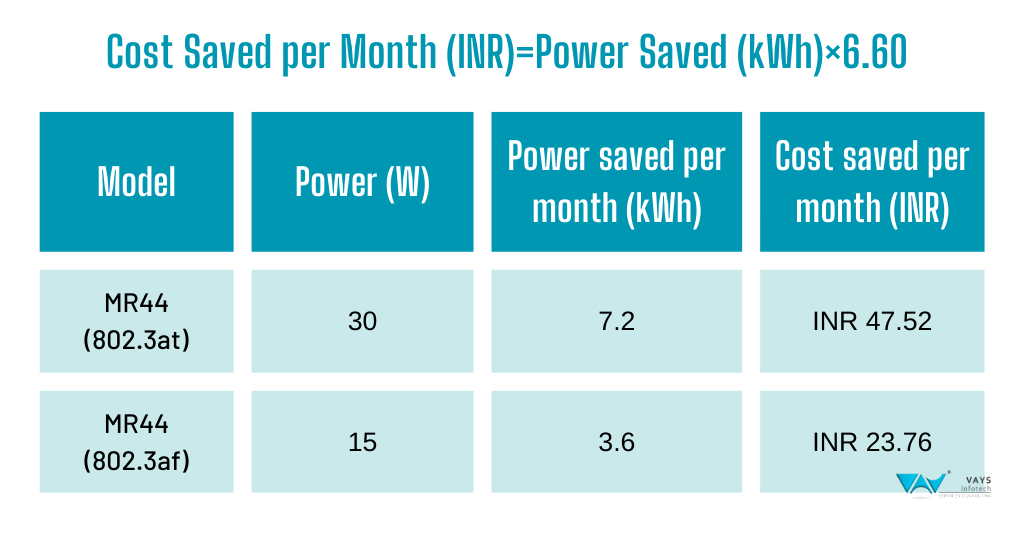As enterprises grow increasingly reliant on wireless infrastructure, the energy demands of networking hardware have become a significant factor in IT operations. Among modern wireless solutions, the Cisco Meraki MR44 access point stands out due to its performance capabilities and dual operating modes.
This article explores the energy efficiency of the MR44 in both its Standard Power Mode (802.3at) and Low Power Mode (802.3af), analyzing monthly energy consumption, heat output, cooling requirements, and cost implications. Additionally, it discusses further energy savings achievable by turning the device off during non-business hours.
Please Note that below discussion of ideas and formulas is based on the Bangalore location (Karnataka), India. The numbers may vary as per the location. The tariff used for calculation of cost is dated 27th March 2025 which is applicable from 1st April 2025.
What Are the Power Modes Available in MR44 Access Point?
The MR44 offers two primary operating configurations:
- Standard Power Mode (802.3at)
Maximum Power Consumption: 30W - Low Power Mode (802.3af)
Maximum Power Consumption: 15W
These modes are in compliance with IEEE 802.3 standards for Power over Ethernet (PoE), widely adopted across enterprise networks for efficient device management.
How much Power is consumed by different Modes: 802.3at Vs 802.3af in Meraki AP MR44 ?
To compute total energy consumption over a month, continuous operation is assumed (24 hours × 30 days). The power consumed is calculated using:
Total Power (kWh)=PW×24×30 / 1000
Where Pw is the power in watts.
What Is the Monthly Cost of Operating Each Mode in Meraki MR44 AP?
For this study, we now refer to Karnataka state electricity tariffs, where the average commercial tariff for LT connections is approximately ₹6.60 per kWh (as per BESCOM – Bangalore Electricity Supply Company, bescom.karnataka.gov.in).
Cost Calculation:
Energy Cost=Power (kWh)×Tariff
Cooling Cost=Cooling Power (kWh)×Tariff

This clearly shows that the Low Power Mode reduces power consumption by 50%, aligning with energy-saving initiatives in green IT environments.
How Much Heat Is Generated and What’s the Cooling Requirement for Meraki MR44 AP?
Electronics convert consumed energy into heat. This thermal output impacts cooling system requirements, especially in data center and dense office environments. Using the conversion:
1 kWh=3412.14 BTU
The heat generated per month is:

Cooling Power is the Power used by an Air Conditioner to cool the heat dissipated by the device for whole months. Cooling requirements are determined by the Coefficient of Performance (COP) of cooling systems. Based on ASHRAE standards (ASHRAE, ashrae.org), a typical cooling efficiency (COP ≈ 3.5) equates to:
Thus, cooling power required is:
Cooling Power (kWh)=Heat Generated (BTU) / 3412.14 X COP

This again illustrates how the low power mode not only reduces power draw but also halves the thermal load on cooling systems.

Interpretation:
By simply scheduling the MR44 device to shut down for 8 hours every night:
- An organization can save ₹47.52 per month per device in standard mode.
- In low-power mode, the saving is ₹23.76 per month per device.
These savings multiply significantly across larger deployments and make a strong case for energy-aware scheduling policies.
What Energy-Saving Tips Can Help Optimize Access Points (AP) Usage?
Organizations can adopt the following strategies to reduce energy consumption and operational costs related to wireless access points like the MR44:
Use Low Power Mode (802.3af) Wherever Applicable
Step: Configure the MR44 access point to run in Low Power Mode through the Meraki dashboard.
Explanation: This instantly reduces the power draw from 30W to 15W without affecting basic functionality in small-to-medium coverage areas. Use this for locations with lower client density or during non-peak hours.
Schedule Night-Time Shutdown
Step: Use the “Power Scheduling” feature in Meraki’s dashboard or an external PoE controller to switch off APs during non-business hours (e.g., 10 PM – 6 AM).
Explanation: Turning off APs for 8 hours saves approximately ₹50 per month per device in Standard Mode. Apply this in offices, classrooms, or areas unused after hours.
Enable Power-Saving Features on Connected Clients
Step: Instruct users to enable client-side Wi-Fi sleep modes and configure APs to support features like 802.11v and 802.11k.
Explanation: These help reduce unnecessary wireless traffic and allow APs to manage power more efficiently by directing clients to roam or sleep.
Deploy Access Points Based on Heat Maps
Step: Conduct a site survey using tools like Ekahau or Meraki’s built-in RF planning tools before installation.
Explanation: Avoid over-deployment. Strategically placing APs ensures maximum coverage with fewer devices, thus saving both energy and cooling loads.
Group APs by Zones and Apply Adaptive Policies
Step: Create network zones (e.g., conference, break room, storage) and apply different power settings per zone via the Meraki dashboard.
Explanation: Not all areas need full coverage 24/7. For example, break rooms can have limited access or sleep mode settings during off-hours.
What Will Happen When MR44 Operates in Low Power Mode?
Ethernet Uplink Speed Downshifts from 2.5 Gbps to 1 Gbps
- The MR44 supports Multigigabit Ethernet (2.5 Gbps) uplinks over CAT5e or better cabling.
- In low power mode, it limits itself to 1 Gbps due to power constraints.
Impact:
- Bandwidth is reduced by 60%, which could bottleneck high-throughput environments, especially if:
- Many clients are connected.
- Heavy applications (e.g., HD video, large file transfers) are in use.
- For small or medium deployments, 1 Gbps is usually still sufficient unless high traffic loads are expected.
5GHz Radio Downshifts from 4×4:4 to 2×2:2
- In standard mode, MR44 offers 4 spatial streams (4×4 MIMO) on the 5GHz band.
- In low power mode, it’s reduced to 2×2 — cutting the number of data streams by half.
Impact:
- Reduced overall throughput on the 5GHz band.
- Lower multi-user capacity, which affects:
- Simultaneous connections
- Speed for high-bandwidth clients (laptops, VoIP, etc.)
- Performance impact is more visible in dense client environments (e.g., offices, conference rooms).
Disables Dedicated IoT Radio (BLE/Thread/Zigbee)
- The Bluetooth Low Energy (BLE) radio, often used for IoT location tracking, asset monitoring, or smart sensors, is disabled.
Impact:
- No IoT integrations possible (like BLE-based location services, proximity triggers).
- Doesn’t affect Wi-Fi functionality — just non-Wi-Fi services.
Disables Dedicated Scanning Radio
The MR44 normally has a separate radio that passively scans the RF environment to:
- Detect rogue APs
- Help with auto RF optimization (channel/power selection)
- Improve Air Marshal security and location analytics
Impact:
- Reduced wireless security scanning and RF analytics.
- May slow down automatic interference detection and mitigation.
- Could reduce efficiency of features like Auto RF, intrusion detection, and client tracking.
Reduces Maximum Transmit Power (Tx Power)
- AP broadcasts Wi-Fi signals at lower strength to conserve power.
- Reduces the coverage area of the AP.
Impact:
- Smaller Wi-Fi coverage zone per AP.
- May lead to:
- Dead zones in large spaces.
- Poor roaming experience for mobile clients.
- You’ll need more APs for full coverage or redesign placement.
When do we use Low Power Mode? Is low Power Mode in APs: a Good or a Bad Choice?
Low Power Mode is Suitable for:
- Small offices with <25 clients.
- Low to medium Wi-Fi usage (web, email, light streaming).
- Budget-focused or power-constrained deployments.
Low Power Mode is Not ideal for:
- Dense/high-performance enterprise setups.
- Environments needing full BLE/IoT support.
- Large open spaces needing broad coverage.
What’s the Final Verdict on MR44’s Power Optimization?
The analysis of the Cisco Meraki MR44 access point across its Standard and Low Power Modes reveals a clear opportunity for energy optimization in enterprise environments. Operating the device in Low Power Mode cuts energy consumption and heat generation by 50%, significantly lowering cooling requirements and reducing overall monthly energy costs. With Karnataka’s commercial electricity tariff at ₹6.60 per kWh, the total cost of operating an MR44 in standard mode costs nearly ₹200 per month — a figure that can be halved simply by switching to low power mode.
A typical Organization based on the floor area and number of users will have more than one access point, Thus cost saving will be very substantial, by adopting certain procedures such as scheduled night-time shutdowns, power mode configuration, strategic AP placement, and zoning policies
These practices not only reduce operational expenses but also contribute to greener, more sustainable IT infrastructure.
Switch models such as Meraki MS120-8LP only provides low power mode (802.3af), So if you want your device to run only on low power mode then use this switch.
Switch models such as Meraki MS120-8FP, MS120-24P, MS120-48LP/FP, MS125, MS210, MS225, MS250 and MS355 provides both standard power mode (802.3at) and low power mode (802.3af), which is configurable in the switch.
How Can Enterprises Create Future-Ready and Sustainable Networks?
By aligning device management with energy efficiency best practices — backed by standards such as ASHRAE and using intelligent features available in platforms like the Meraki dashboard — organizations can scale their wireless deployments without proportionally increasing their energy footprint. This approach is essential for future-ready networks that value both performance and sustainability.
To know more about Cisco Meraki Solutions, click here on Cisco Meraki


Energy-efficient access points like the MR44 reduce power consumption while maintaining performance, helping lower energy bills and environmental impact. Choosing smart tech supports sustainability without sacrificing connectivity quality.